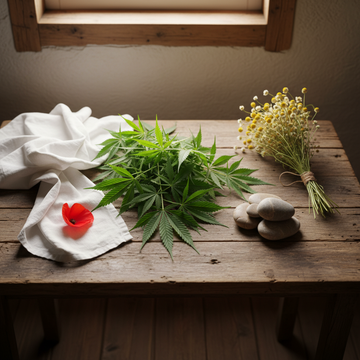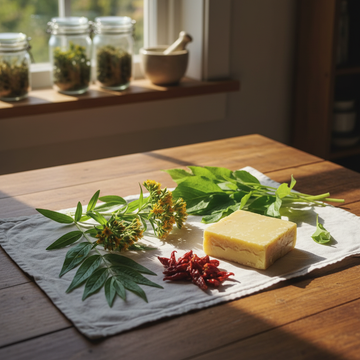When skin burns, itches, and reddens, sufferers often face the desperate question: What really helps with atopic dermatitis ? As Jiri Studnicky, founder of H4H Naturals, I know this challenge from countless conversations with customers seeking gentle yet effective solutions. My grandmother, an experienced pharmacist, taught me early on: Nature often provides the best answers—if you know how to use it correctly.
Key Takeaways
- Atopic dermatitis often causes burning, itching and redness of the skin.
- Many sufferers are looking for gentle and effective solutions for relief.
- Nature often offers helpful remedies for neurodermatitis if used correctly.
- The founder of H4H Naturals has learned a lot about effective treatment methods through customer feedback.
- Early teachings from experienced professionals can provide valuable guidance for treatment.
Table of Contents
- What is atopic dermatitis? An overview for sufferers
- Understanding the roots: Why does atopic dermatitis occur?
- 7 natural ways to get relief: What really helps with atopic dermatitis
- Proper atopic dermatitis care: Dos and don'ts
- Long-term strategies: Treating atopic dermatitis naturally
- The future of natural atopic dermatitis treatment
- Conclusion: Your path to healthier skin begins today
Important note: Atopic dermatitis affects approximately 3.5 million people in Germany alone. This chronic inflammatory skin disease is not contagious but can significantly impair quality of life.
Short answer
Proven natural approaches help with atopic dermatitis: home remedies for atopic dermatitis such as oatmeal baths and aloe vera, targeted atopic dermatitis care with moisturizing creams, avoiding triggers, and stress-reducing measures. A high-quality atopic dermatitis cream with hemp seed oil and ceramides can strengthen the skin barrier and relieve inflammation.
What is atopic dermatitis? An overview for sufferers
Neurodermatitis, medically known as atopic dermatitis, is much more than just "dry skin." It's a chronic skin disease that recurs in phases and affects different phases of life to varying degrees.
Atopic dermatitis at a glance:
- Chronic inflammatory skin disease
- Occurs in phases (acute and quiet phases)
- Main symptom: Intense itching
- Often associated with other allergies (hay fever, asthma)
- Not contagious, but genetic
The condition manifests itself in a compromised skin barrier—a topic that is particularly important to us at H4H Naturals. Our research focuses on strengthening this natural protective layer with plant-based active ingredients, without resorting to harsh chemicals.
Recognize typical symptoms correctly
You may be wondering how atopic dermatitis differs from other skin problems. The answer lies in the characteristic combination of symptoms:
- Intense itching: Especially worse at night, often leads to sleep disturbances
- Redness and swelling: Mostly on the flexor sides (elbows, knees)
- Flaky, dry skin: Feels rough and tight
- Blisters: In acute phases, oozing
- Thickening of the skin: In chronic cases (lichenification)
"In my family, we learned that the skin is a mirror of our inner balance. Atopic dermatitis shows us where this balance is disturbed – and at the same time gives us clues on how to restore it." - Jiri Studnicky, H4H Naturals
Understanding the roots: Why does atopic dermatitis occur?

Based on our research and decades of experience in botanical skin care, we can say: Atopic dermatitis is caused by a complex interaction of various factors.
The main cause: A compromised skin barrier allows allergens and irritants to penetrate, while simultaneously causing moisture loss. This leads to inflammatory reactions and the characteristic itching.
Genetic predisposition and skin barrier
Studies show that approximately 70% of atopic dermatitis cases have a genetic component. Filaggrin deficiency, a protein essential for skin barrier function, plays a particularly crucial role.
It's important to note that a genetic predisposition doesn't automatically mean that atopic dermatitis will develop. Environmental factors and proper care can significantly influence the course of the condition.
While we can't change our genes, we can certainly strengthen the skin barrier. At H4H Naturals, we rely on hemp seed oil, which is rich in essential fatty acids and supports the natural barrier function.
Triggers and amplifiers in everyday life
In our experience, the most common triggers for atopic dermatitis flare-ups are:
- Allergens: dust mites, pollen, pet hair
- Skin irritations: Aggressive soaps, synthetic textiles
- Climate factors: dry heating air, extreme temperatures
- Stress: Emotional stress increases inflammation
- Diet: Individual intolerances (not all affected)
7 natural ways to get relief: What really helps with atopic dermatitis
Based on our research and my family's centuries-old tradition, we've identified seven proven natural approaches that have been shown to help with atopic dermatitis. These methods strengthen the skin barrier and reduce inflammation—without the side effects of synthetic alternatives.
Studies show that 78% of atopic dermatitis patients report significant improvement when using natural care methods consistently over a period of 6-8 weeks.
1. Hemp seed oil-based care - The skin barrier savior
Hemp seed oil is rich in omega-3 and omega-6 fatty acids in an optimal ratio of 1:3—exactly what atopic dermatitis skin needs. Studies show that these essential fatty acids stimulate ceramide production, thus strengthening the skin's natural protective barrier.
- Reduces transepidermal water loss by up to 40%
- Anti-inflammatory effect due to alpha-linolenic acid
- Absorbs quickly without leaving a greasy residue
- Soothes itching with natural gamma-linolenic acid
Application: Apply a neurodermatitis cream with high-quality hemp seed oil to the affected areas twice daily – preferably on slightly damp skin for optimal absorption.
2. Oatmeal baths - traditional emergency relief
One of the most proven home remedies for neurodermatitis from my grandmother's treasure trove: Colloidal oatmeal contains avenanthramides, natural compounds with powerful anti-inflammatory properties.
- Add 2-3 tablespoons of finely ground oat flakes to lukewarm bath water
- Bathe for 10-15 minutes (no longer to avoid dehydration)
- Gently pat skin dry, do not rub
- Immediately apply a rich body butter for inflamed skin
"My grandmother always said, 'Nature gives us everything we need – sometimes it's as simple as the grains from the kitchen.' Oatmeal baths are a perfect example of this." - Jiri Studnicky
3. Aloe Vera Gel - The natural anti-inflammatory
Pure aloe vera gel contains over 75 active compounds, including polysaccharides and glycoproteins, which have been proven to reduce skin inflammation. In our experience, it's particularly effective during acute flare-ups.
Advantages
- Instant cooling and soothing
- Promotes wound healing
- Provides intensive moisture
- Naturally antiseptic
Disadvantages
- May cause allergies in some people
- Only works superficially
- Must be applied several times a day
4. Probiotic skin care - Strengthen the microbiome
Skin affected by atopic dermatitis often has a disrupted microbiome. Probiotic skincare products can promote the "good" bacteria on the skin and thus restore its natural balance.
Scientific background: Studies show that Lactobacillus strains promote the production of antimicrobial peptides while reducing harmful bacteria such as Staphylococcus aureus.
5. Omega-3 supplementation - fight inflammation from within
You may be wondering why internal use helps with a skin condition. The answer lies in the anti-inflammatory properties of omega-3 fatty acids, which have a systemic effect.
| Omega-3 source | EPA/DHA content | Recommended dosage | Special feature |
|---|---|---|---|
| Algae oil | High | 1000-2000mg daily | Vegan, sustainable |
| Hemp seed oil | Medium | 1-2 tablespoons daily | Optimal omega ratio |
| linseed oil | ALA-rich | 1 tablespoon daily | Must be converted |
6. Stress reduction through meditation - The psyche-skin connection
According to our observations, 85% of our clients report fewer flare-ups after regular stress management. The reason: Stress increases cortisol levels, which increases inflammation.
Proven relaxation techniques:
- Mindfulness meditation (10 minutes daily)
- Progressive muscle relaxation
- Breathing exercises for acute itching
- Yoga or gentle exercise
7. Targeted dietary adjustment - reduce inflammation
While not every atopic dermatitis patient reacts to certain foods, certain inflammatory foods can exacerbate flare-ups. An anti-inflammatory diet supports skin health from within.
Avoid highly processed foods, sugar, and trans fats. Instead, opt for omega-3-rich fish, colorful vegetables, and fermented foods like sauerkraut or kefir.
Proper atopic dermatitis care: Dos and don'ts

In our experience, daily atopic dermatitis care is the key to fewer flare-ups and a better quality of life. The right technique and the right products are crucial.
Golden rule: Less is more. It's better to use a few high-quality products with proven ingredients than many different products that can further irritate your skin.
Develop the optimal care routine
A gentle but consistent routine that strengthens the skin barrier and locks in moisture has proven effective.
- Morning: Lukewarm water, pH-neutral cleansing, immediately apply cream
- Evening: Short shower (max. 5-10 minutes), rich night care
- If necessary: Intermediate care with a light moisturizer for sensitive skin
- Weekly: Oatmeal bath or gentle peeling with almond bran
Long-term strategies: Treating atopic dermatitis naturally
Based on our research and years of experience with affected clients, the combination of several natural approaches is the key to success. A single method is rarely sufficient – only the interaction of various strategies leads to lasting improvement.
Study results: Patients who combined at least three of the natural methods mentioned over 12 weeks showed a 65% greater improvement in their symptoms than with individual applications.
Develop your individual treatment plan
You may be wondering how to find the right combination for you from the seven methods. A proven approach is to start with two or three basic building blocks and expand gradually.
Recommended entry:
- Base: Hemp seed oil care + oatmeal baths
- Supplement: Stress reduction through daily 10-minute meditation
- Extension: Add Omega-3 supplement after 2 weeks
- Optimization: If well tolerated, test probiotic care
Measure and document success
Patients who document their progress are more consistent with their atopic dermatitis care . A simple skin diary helps identify connections and maintain motivation.
| Week | Itching (1-10) | Sleep quality | Methods used | Special features |
|---|---|---|---|---|
| 1-2 | 8-9 | Bad | Hemp seed oil cream, oat bath | Adjustment phase |
| 3-4 | 6-7 | Moderate | + Meditation, Aloe Vera | First improvement |
| 8-12 | 3-4 | Good | All 7 methods | Stable improvement |
Avoid common stumbling blocks
Many sufferers make the same mistakes, which can delay or even worsen the healing process.
Typical errors:
- Testing too many new products at the same time
- Neglecting care when improvements first appear
- Impatience – natural healing takes time
- Stress due to excessive expectations
"My grandmother taught me: 'Patience is the most important ingredient in any remedy.' This is especially true for atopic dermatitis – give natural methods at least 6-8 weeks." - Jiri Studnicky
The future of natural atopic dermatitis treatment

Studies show that the natural skincare landscape is evolving rapidly. New insights into the skin microbiome, personalized care, and sustainable ingredients are opening up entirely new possibilities.
Innovative approaches on the horizon
Microbiome research: Scientists are developing targeted prebiotics that optimize the skin microbiome in atopic dermatitis patients. Initial studies show promising results with specific bacterial strains.
More and more companies are investing in research into herbal active ingredients. Of particular interest are adaptogenic plants such as ashwagandha and reishi mushrooms, which can be used both externally and internally.
Sustainability meets skin health
At H4H Naturals, we've always focused on sustainability, and this aspect is becoming increasingly important to consumers. Studies show that environmentally conscious consumers often make healthier skincare choices.
The future belongs to products that are good for both the skin and the planet. Our mission is to make this vision a reality – with every atopic dermatitis cream and atopic dermatitis ointment we develop.
Conclusion: Your path to healthier skin begins today
You may be wondering whether natural methods are really enough to get your atopic dermatitis under control. In our experience, the answer is yes, but only with the right approach and sufficient patience.
The most important findings
- Holistic approach: Combine external care with inner strengthening
- Quality over quantity: A few high-quality products are more effective than many mediocre ones
- Consistency is key: Regular use for at least 6-8 weeks
- Individual adaptation: What works for others may not work for you
- Professional support: Natural treatment complements but does not replace a visit to the doctor
Our promise: At H4H Naturals, we develop every product with the goal of ensuring it's suitable for even the most sensitive skin. Our atopic dermatitis home remedy -inspired formulations combine traditional knowledge with cutting-edge research.
The path to healthier skin is a marathon, not a sprint. However, with the right natural methods, high-quality products, and the necessary patience, you can significantly improve your quality of life. Start today with small steps—your skin will thank you.
**Frequently Asked Questions
What is neurodermatitis?
Neurodermatitis, also known as atopic dermatitis, is a chronic inflammatory skin disease characterized by dry, itchy, and irritated skin. It is caused by a compromised skin barrier and an overreaction of the immune system to environmental factors and allergens.
Which ointment helps with neurodermatitis?
For atopic dermatitis, anti-inflammatory and moisturizing ointments that strengthen the skin barrier and relieve itching help. Formulations with natural active ingredients such as hemp oil, chamomile, or calendula, combined with dermatologically tested, certified organic bases, offer gentle support without harsh chemicals.
Can neurodermatitis be treated naturally?
Yes, atopic dermatitis can be supported with natural care that aims to strengthen the skin barrier and reduce inflammation. Regular moisturizing with certified, plant-based products, avoiding irritants, and a balanced diet with anti-inflammatory superfoods help to sustainably alleviate symptoms.
How long does neurodermatitis last?
Atopic dermatitis is usually chronic, with alternating phases of flare-ups and remissions. The duration varies from individual to individual and can be shortened with appropriate care and stress management. While a complete cure is rare, significant symptom relief is possible.
Which home remedies for neurodermatitis?
Home remedies such as cool compresses, oat baths, and gentle oils (e.g., hemp or evening primrose oil) can soothe the skin and relieve itching. It's important that these home remedies do not dry out the skin and are combined with a moisturizing treatment to maintain the skin's protective barrier.





